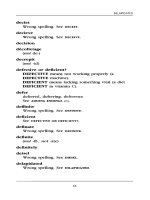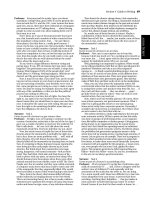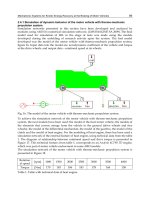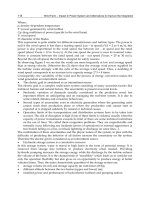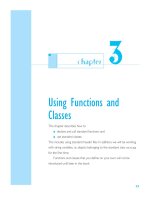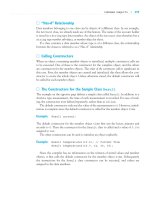How to Survive in Anaesthesia - Part 6 docx
Bạn đang xem bản rút gọn của tài liệu. Xem và tải ngay bản đầy đủ của tài liệu tại đây (202.53 KB, 21 trang )
Treatment
Treatment is dependent on correct identification of the cause. Rapid
intravenous infusion of colloid fluid or blood may be required,
together with measurement of the central venous pressure. The use of
inotropic drugs should only be considered when you are sure that
there is an adequate circulating blood volume. Epinephrine
(adrenaline) is not an appropriate treatment for the hypotension of
haemorrhage.
Laryngospasm
Reflex closure of the glottis from spasm of the vocal cords is due
usually to laryngeal stimulation. Common causes include insertion of
a Guedel airway or laryngoscope, the presence of a tracheal tube, and
secretions in the airway. It can also arise as a response to surgical
stimulation in a lightly anaesthetised patient. Thus, it occurs not
only on induction of anaesthesia but also intraoperatively, and
occasionally postoperatively.
The airway obstruction can lead to hypoxia and, in severe cases,
pulmonary oedema can result.
Treatment
The management of laryngospasm depends on its severity, as shown
in Box 17.4.
Common intraoperative problems
89
Box 17.3 Major causes of intraoperative hypotension
• Decreased venous return:
•
haemorrhage
• vena caval compression – obstetrics, prone position
• drugs, infection
• Myocardial depression:
• mechanical
• intermittent positive pressure ventilation
• equipment and circuit malfunction
• pneumothorax
• cardiac tamponade
• pulmonary embolus
• cardiac disease
• drugs
emedicina
How to Survive in Anaesthesia
90
There is a belief that a patient with severe laryngospasm and cyanosis
will gasp a breath just before hypoxaernia is fatal. Do not try to verify
this tenet – if in doubt paralyse and ventilate the patient.
Wheeze
Wheeziness during anaesthesia may be caused by many factors other
than bronchospasm (Box 17.5). These causes must be eliminated
before treatment for bronchospasm is started.
Complications associated with intubation often cause wheeze and it
is essential to check the position and patency of the endotracheal
tube first.
Treatment
Treatment of intraoperative bronchospasm is as follows.
(1) Consider changing volatile agent to halothane (bronchodilator).
(2) Give salbutamol 250 micrograms slowly intravenously.
Box 17.4 Management of laryngospasm
(1) Identify stimulus and remove, if possible.
(2) Give 100% O
2
and get help.
(3) Ensure patent airway.
(4) Tighten expirator y valve to apply a positive air way pressure to “break”
the spasm and increase O
2
intake with each breath.
(BE CAREFUL.)
(5) If unable to ventilate, give suxamethonium, endotracheal intubation,
and deepen anaesthesia. Ensure intubation and ventilation is feasible.
Box 17.5 Differential diagnoses of wheeze
• Oesophageal intubation
• Tracheal tube in right main bronchus
• Kinked tracheal tube
• Tracheal tube cuff herniation over end of tube
• Secretions in tracheal tube
• Secretions in trachea/lungs
• Gastric acid aspiration
• Pneumothorax
• Pulmonary oedema
• Bronchospasm
emedicina
(3) Give aminophylline 250–500 mg (4–8 mg/kg) intravenously
over 10–15 min.
(4) Give epinephrine 0·5–1·0 ml 1:10 000 increments intravenously.
(5) Give hydrocortisone 100 mg intravenously.
Conclusion
Many problems occur during the induction and maintenance of
anaesthesia, and recovery of a patient. Whatever the problem, a cause
must be sought in the following sequence: anaesthetic–surgical–
medical. Only when the first two have been eliminated should
specific medical therapy be started.
Common intraoperative problems
91
emedicina
92
18: Postoperative problems
Intraoperative problems described in the previous chapter (arrhythmias,
hypotension, laryngospasm, and wheeze) may continue, or even start,
in the postoperative period. Investigation of the cause and subsequent
management of these problems is identical, regardless of the time
of onset.
Airway obstruction
Obstruction of the airway is a common occurrence after anaesthesia.
It must be rapidly diagnosed (Box 18.1), the cause sought (Box 18.2),
and appropriate treatment started.
During emergence from anaesthesia patients may have incomplete
mouth, pharyngeal, and laryngeal control, causing airway
obstruction. Hypoxaemia will result if the airway is not maintained.
Patients are turned routinely into the lateral or “recovery position” to
help prevent this problem. The patient is usually placed in the left
lateral position as reintubation is easier because laryngoscopes are
designed to be inserted into the right side of the mouth.
If there is a possibility that aspiration may have occurred with the
patient in the supine position, then they should be placed in the right
lateral position to prevent contamination of the left lung.
Box 18.1 Signs of airway obstruction
• “See-saw” respiration pattern
• Suprasternal and intercostal recession
• Tachypnoea
• Cyanosis
• Tachycardia
• Arrhythmias
• Hypertension
• Anxiety and distress
• Sweating
• Stridor
emedicina
Patients who are at risk of aspiration should be extubated when the
airway reflexes are intact. Although this is less pleasant for the
patient, it is much safer.
The treatment of airway obstruction is to identify the cause, and clear
the airway, often with suction, to ensure patency. Extension of the
neck, jaw thrust, and insertion of an oropharyngeal airway are often
required. Laryngeal oedema is treated by intravenous dexamethasone
8 mg. Oxygenation of the patient is the priority and, if you are in
doubt, reintubation must be undertaken. Many problems in
anaesthesia are caused by inadequate attention to the airway.
Remember, a patent airway is a happy airway.
Failure to breathe
Failure to breathe adequately at the end of anaesthesia has many
causes, both common (Box 18.3) and unusual (Box 18.4).
Postoperative problems
93
Box 18.2 Common causes of postoperative airway obstruction
• Anaesthesia
• unconsciousness with obstruction by tongue
• laryngeal oedema
• laryngeal spasm (Chapter 17).
• Surgery
• vocal cord paralysis (thyroid surgery)
• neck haematoma
• preoperative neck and face inflammation (infection)
Box 18.3 Common causes of failure to breathe
• Central nervous system
• depression from drugs:
• opiates
• inhalational agents
• decreased respiratory drive:
• hypocapnia
• Peripheral
• failure of neuromuscular transmission:
• inadequate reversal of competitive relaxants
• overdosage of competitive relaxants
• cholinesterase deficiency
emedicina
Differentiation between central and peripheral causes of failure to
breathe can only be made by using a nerve stimulator. A peripheral
nerve, such as the ulnar nerve at the wrist, is stimulated. Ensure that
the nerve stimulator is working correctly; if necessary, try it on
yourself first.
Adequate return of neuromuscular function is assessed by observing a
“train of four” stimulation. Four twitches should be seen and the ratio
of twitch four : twitch one response must exceed 70%. This is not easy
to decide and we recommend that they should appear about equal.
This ensures safety. A sustained tetanic response following high
frequency stimulation also indicates adequate neuromuscular
function (Box 18.5).
If a nerve stimulator is not available, there are clinical tests that can
be made to indicate the return of normal neuromuscular activity. If
How to Survive in Anaesthesia
94
Box 18.4 Unusual causes of failure to breathe postoperatively
• Hypothermia
• Drug interactions:
• aminoglycosides and competitive relaxants
• ecothiopate and suxamethonium
• Central nervous system damage
• Electrolyte disorders:
• hypokalaemia
• Undiagnosed skeletal muscle disorders:
• myasthenia gravis
• Extensive spinal anaesthetic in combination with general anaesthesia
Box 18.5 Signs of adequate neuromuscular function
• Evoked responses:
• train of four ratio > 70%
• sustained tetanic response to high frequency stimulation
• return of single twitch to control height
• Clinical responses:
• lift head for 5 s
• sustained hand grip
• open eyes widely
• sustained tongue protrusion
• effective cough
• adequate tidal volume
• vital capacity 15–20 ml/kg
emedicina
inadequate neuromuscular function is found, the lungs must be
ventilated and the use of neuromuscular blocking drugs reviewed.
Prolonged apnoea after suxamethonium occurs when the patient has
an abnormal genetic variant of the plasma enzyme, cholinesterase.
The patient and members of the family should be investigated at a
later date and susceptible individuals asked to carry warning cards.
Only when you are certain that neuromuscular transmission is
normal, should a central cause for failure to breathe be considered.
Again the lungs must be ventilated, a normal end-tidal CO
2
concentration obtained and possible causes assessed (see Box 18.3).
An overdose of opioid is a common reason for failure to breathe. This
can be treated with low doses of intravenous naloxone 40 microgram,
but this potent antagonist is short-acting and the return of adequate
respiration is usually accompanied by a complete lack of analgesia!
This is an unsatisfactory mess and it is better to ventilate the lungs
until the central depressant effects of the drugs have worn off, or
consider intravenous doxapram.
Nausea and vomiting
Nausea and vomiting are particularly unpleasant complications of
anaesthesia and surgery. The avoidance of these problems is more
important to some patients than the provision of adequate analgesia.
There are many factors associated with the occurrence of nausea and
vomiting (Box 18.6). This long list indicates that often there is no
single, identifiable cause, although opioids are frequently at fault.
Postoperative problems
95
Box 18.6 Factors associated with postoperative vomiting
• Patient predisposition
• age, sex, menstrual cycle, obesity
• history of postoperative vomiting
• history of motion sickness
• anxiety, pain
• recent food intake, prolonged fasting
• Surgical factors
• type of surgery
• emergency surgery
• Anaesthetic factors
• inhalational agents
• intravenous induction agents
• opiates
• duration of anaesthesia
emedicina
Because patients find nausea and vomiting distressing, it should be
prevented if possible. The medical consequences of vomiting include
the possibility of acid aspiration, electrolyte imbalance and
dehydration, inability to take oral drugs, and disruption of the wound.
A vomiting patient upsets other patients in the recovery area and
surgical ward. Most anaesthetists give antiemetics routinely. Drugs used
include cyclizine, prochlorperazine, droperidol, metoclopramide, and
ondansetron. The newer agents seem little better than traditional drugs.
Delayed awakening
Failure to recover full consciousness after surgery is always worrying
for the anaesthetist. A systematic review of the patient is necessary
(Box 18.7).
The most common causes are drug-related, but you must also
remember the possibility of a low temperature, low blood glucose, low
plasma sodium, and low circulating thyroid hormones.
How to Survive in Anaesthesia
96
• distension of gut
• oropharyngeal stimulation
• experience of anaesthetist
• Postoperative factors
• pain
• hypotension
• hypoxaemia
• movement of patient
• first intake of fluids/food
• early mobilisation
Box 18.7 Causes of delayed recovery
• Hypoxaemia
• Hypercapnia
• Residual anaesthesia
• Drugs, especially opiates
• Emergence delirium from ketamine, scopolamine, atropine
• Neurological causes
• Surgery: neurosurgery, vascular surgery
• Metabolic causes:
• hypoglycaemia
• hyponatraemia
• Medical causes: hypothyroidism
• Sepsis
• Hypothermia
emedicina
Shivering
Shivering is common during recovery from anaesthesia, but is not
obviously related to a low core temperature in the patient. It is more
frequent in young men who have received volatile agents and its
incidence is decreased by the use of opiates during anaesthesia. The
main deleterious effect of shivering is an increase in O
2
consumption.
This is of little consequence in young, fit patients, but it should be
treated promptly in the elderly who often have impaired cardiac and
respiratory function.
Pethidine 25 mg intravenously is effective in stopping shivering;
other opiates can also be used. Low doses of intravenous doxapram
are an alternative to opiates if there is a risk of respiratory depression.
The simple application of heat to the “blush area” (the face and upper
chest) stops shivering. This indicates the importance of skin
temperature in stimulating shivering, as the effect on body
temperature is negligible.
Temperature disturbances
A decrease in body temperature is an inevitable accompaniment of
anaesthesia. Indeed, it has been noted that the most effective means
of cooling a person is to give an anaesthetic. Hypothermia (defined as
a core temperature < 35°C) can occur after major surgery and the
predisposing factors are shown in Box 18.8.
Complications of postoperative hypothermia may include shivering
(see above), impaired drug metabolism and enhanced platelet
aggregation. There are several methods available for preventing loss
of body heat during surgery (Box 18.9), and a combination of
treatments is necessary. For example, the theatre temperature must be
Postoperative problems
97
Box 18.8 Factors predisposing to postoperative hypothermia
• Ambient theatre temperature
• Age, young and elderly
• Surgery
• duration
• size of incision
• insulation
• Concomitant disease
• Intravenous fluid administration
• Drug therapy such as vasodilators
emedicina
maintained at 24°C, the inspired gases humidified, the intravenous
fluids warmed and the skin surface warmed.
Hyperthermia after anaesthesia is uncommon (Box 18.10). In the list
below infection is the most common cause, and the potentially lethal
complication of malignant hyperthermia should only be diagnosed
after arterial gas analysis and determination of circulating potassium
values (see Chapter 14).
Cyanosis
Cyanosis is a serious sequelae of anaesthesia and, whenever it occurs,
must be investigated promptly.
(1) Check oxygen delivery from anaesthetic machine and circuit.
(2) Check airway. Is endotracheal tube correctly positioned and
patent?
How to Survive in Anaesthesia
98
Box 18.9 Prevention of body heat loss
• Ambient theatre temperature
• Airway humidification
• Warm skin surface
• passive insulation
• active warming
• water blanket
• radiant heater
• forced air warmer
• Warm intravenous fluids
• Oesophageal warming
Box 18.10 Causes of hyperthermia
• Infection
• Environmental
• Mismatched transfusion
• Drugs
• interactions
• atropine overdose
• Metabolic
• malignant hyperthermia
• phaeochromocytoma
• hyperthyroidism
emedicina
(3) Having excluded these causes, consider:
• fault in chest (is ventilation easy?):
• bronchospasm
• pulmonary oedema
• pneumothorax
• pulmonary effusion/haemothorax.
• fault in circulation:
• decreased venous return
• cardiac failure
• embolism
• drug reaction.
(4) Rare causes include:
• methaemoglobinaemia
• malignant hyperthermia.
Problems of the airway are the most common causes of cyanosis and
you must be certain that the airway is patent and the patient is
breathing O
2
before considering other causes.
Conclusion
Postoperative problems often reflect errors of judgement made during
surgery. Get it right intraoperatively and your patients will have fewer
difficulties postoperatively. Nursing staff in the recovery area and
surgical wards rapidly assess your anaesthetic skills by the smoothness
of recovery of your patients.
Postoperative problems
99
emedicina
emedicina
Part III
Passing the gas
As the weeks of your anaesthetic career become months, you will play
an increasing part in the preoperative assessment of patients and the
conduct of the anaesthetic. In this section of the book we describe
briefly the anaesthetic considerations of some of the common surgical
specialties with which a trainee is often involved. We have deliberately
excluded any pharmacology of the anaesthetic drugs; trainees should
obtain an appropriate pharmacology textbook. There is no evidence to
show any benefit from a particular anaesthetic technique in terms of
postoperative morbidity and mortality. The principles of anaesthesia
are more important than the choice of drugs.
The key feature of this section is the need for a thorough preoperative
evaluation of all patients. This is the cornerstone of safe anaesthetic
practice and must never be omitted.
emedicina
emedicina
19: Preoperative evaluation
Preoperative evaluation is used to assess the anaesthetic risks in
relation to the proposed surgery, to decide the anaesthetic
technique (general, regional, or a combination) and to plan the
postoperative care including any analgesic regimens. Explanation of
the relevant details of the anaesthetic can be given, and the use of
premedication can be discussed. Patients waiting for surgery are
vulnerable and a friendly, professional approach by the anaesthetist
is essential.
Operations are classified into four groups (Box 19.1).
This classification has been agreed with the surgeons, but their
memory often fails, so do not be surprised to find elective cases
suddenly classified as emergencies! This is usually done for surgical
convenience.
It is sometimes difficult to convey an overall impression of the
complexity of a patient’s medical condition and this can be done by
referring to one of the five American Society of Anesthesiologists
(ASA) Physical Status Classes (Box 19.2). It is important to remember
that this only refers to the physical status of the patient and does not
consider other relevant factors such as age, and nature and duration
of surgery.
103
Box 19.1 Classification of operations
• Emergency : immediate operation within one hour of surgical
consultation and considered life-saving, for example,
ruptured aortic aneurysm repair.
• Urgent : operation as soon as possible after resuscitation, usually
within 24 hours of surgical consultation, for example,
intestinal obstruction.
• Scheduled : early operation between 1 and 3 weeks, which is not
immediately life-saving, for example, cancer surgery,
cardiac surgery.
• Elective : operation at a time to suit both the patient and
surgeon.
emedicina
Preoperative assessment is outlined below:
(1) history
• age
• present illness
• drugs
• allergies
• past history (operations and anaesthetics)
• anaesthetic family history
• social (smoking, alcohol)
(2) examination
• AIRWAY (see Chapter 1)
• teeth
• general examination
(3) specific assessment
(4) investigations
(5) consent
(6) premedication.
The history of the present illness is important. For example, in
orthopaedic surgery, a fractured neck of femur may occur for many
reasons: a fall from an accident, stroke, cardiac episode (Stokes-Adams
attack) or a spontaneous fracture from a metastasis.
The subsequent examination and investigations are obviously
different in each case. Details of any previous anaesthetics may
indicate difficulties with endotracheal intubation. Unfortunately
successful intubation in the past is no guarantee of future success.
A family history of cholinesterase deficiency and malignant
hyperthermia should be sought.
How to Survive in Anaesthesia
104
Box 19.2 ASA physical status classes
• ASA 1: normal healthy patient.
• ASA 2: patient with mild controlled systemic disease that does not affect
normal activity, for example, mild diabetes, mild hypertension.
• ASA 3: patient with severe systemic disease which limits activity, for
example, angina, chronic bronchitis.
• ASA 4: patient with incapacitating systemic disease that is a constant
threat to life.
• ASA 5: moribund patient not expected to survive 24 hours either with or
without an operation.
• E: emergency procedure.
emedicina
A specific assessment of the concurrent disease(s) must also be
undertaken. The problem of obesity is evaluated as shown in Box 19.3.
Only appropriate investigations should be undertaken. A typical list
of basic tests is shown in Box 19.4.
A lot of money is wasted on unnecessary preoperative tests. When
you have taken a history from the patient and conducted the relevant
examination, you must then decide what tests, if any, are required. A
young, fit sportsman for an arthroscopy requires no further
investigation; whereas an elderly West Indian patient who has
diabetes, hypertension, coronary artery disease, and needs major
vascular surgery, requires all the tests listed in Box 19.4 and probably
more. In many hospitals there are guidelines on the use of
preoperative investigations. These can be helpful, as they reflect local
Preoperative evaluation
105
Box 19.3 Specific assessment of obesity
• Psychological aspects
• Drug metabolism
• Associated diseases
• hypertension
• coronary artery disease
• diabetes
• Difficult venous access
• Airway
• difficult to intubate
• difficult to maintain
• Hypoxaemia more likely intraoperatively – ventilation mandatory
• Regional anaesthesia – difficult to perform
• Position of patient for surgery
• Postoperative analgesia and physiotherapy to decrease chest
complications
• Immobility and deep vein thrombosis – prophylaxis
• Wound dehiscence and wound infection
Box 19.4 Basic preoperative tests
• Haemoglobin concentration
• Screening for sickle cell disease
• Blood urea, creatinine and electrolyte concentrations
• Blood glucose
• Chest
x
-ray film
• ECG
emedicina
practice. For example, you may find that there is far greater use of
preoperative chest x-ray films in regions with a high population of
recent immigrants to exclude tuberculosis.
On completion of the preoperative assessment, and with the results of
the relevant investigations available, a plan for the anaesthetic care of
the patient can be decided. The following surgical factors must also be
considered.
• When is the operation to occur?
• Who is operating?
• Where is the patient going postoperatively (home, ward, HDU, ITU)?
Occasionally it is necessary to postpone surgery. This is most often
done on medical grounds, for example to improve cardiac failure,
treat arrhythmias, and control blood pressure. In the early months of
your anaesthetic career, seek senior advice before postponing surgery;
this prevents prolonged arguments with surgical colleagues.
Premedication
The use of premedication is declining, although most anaesthetists
undergoing surgery demand heavy sedation. The wishes of the
patient must be considered. The main reasons for giving
premedication are shown in Box 19.5.
A variety of drugs including opiates, benzodiazepines,
anticholinergics, phenothiazines, and H
2
receptor blocking drugs are
used. It is important to remember that opiates may make patients
vomit. Topical EMLA cream can be used to prevent the pain of
insertion of a cannula. This eutectic mixture of prilocaine and
lignocaine (1 g of EMLA contains 25 mg of each) is applied to the
How to Survive in Anaesthesia
106
Box 19.5 Reasons for premedication
• Anxiolysis
• Antisialagogue
• Analgesia
• Antiemesis
• Amnesia
• Decreased gastric acidity
• Part of anaesthetic technique (assist induction)
• Prevention of unwanted vagal responses
• Prevention of needle pain
emedicina
dorsum of the hands for a minimum of 1 hour to a maximum of
5 hours before induction of anaesthesia.
Drug therapy
Drug therapy is usually continued throughout the operative period,
especially cardiac and antihypertensive drugs. Patients taking
oral contraceptives and hormone replacement therapy require
thromboprophylaxis with subcutaneous low molecular weight
heparin and graduated elastic compression stockings. Potential
interactions with anaesthetic drugs should be considered.
Preoperative starvation
An empty stomach decreases the risk of vomiting and regurgitation.
Food is usually withheld for 4–6 hours before elective surgery and in
some hospitals it is now common practice to allow clear fluids until
2 hours before surgery. For emergency surgery these guidelines are
inappropriate and the only safe practice is to assume that the stomach
is not empty (see Chapter 21).
Conclusion
Preoperative assessment is often difficult and its importance should
not be underestimated. The anaesthetic care of the patient can only
be planned after a thorough assessment, together with the results
of relevant investigations, and precise knowledge of the proposed
surgery.
Preoperative evaluation
107
emedicina
108
20: Regional anaesthesia
Local anaesthetic agents are used to provide intraoperative analgesia,
either as the sole anaesthetic technique or in combination with
sedation or general anaesthesia. You should learn the principles of
regional anaesthesia at an early stage of your training.
The drugs in common use are lignocaine, bupivacaine, and prilocaine
and their characteristics are shown in Table 20.1. The choice of drug
depends on the speed of onset and duration of action required.
Epinephrine (adrenaline) prolongs the latter.
Local anaesthetic drugs have serious side effects if given in excess, or
inadvertently into the circulation. Toxicity is manifest in a variety of
ways ranging from mild excitation to serious neurological and fatal
cardiac sequelae (Box 20.1).
Table 20.1 Characteristics of local anaesthetic drugs
Agent Duration Maximum dose
(h) plain with epinephrine
(mg/kg) (mg/kg)
Lignocaine 1–3 3 7
Bupivacaine 1–4 2 2
Prilocaine 1–3 4 8
Box 20.1 Symptoms and signs of local anaesthetic toxicity
• Anxiety
• Restlessness
• Nausea
• Tinnitus
• Circumoral tingling
• Tremor
• Tachypnoea
• Clonic convulsions
• Arrhythmias
• ventricular fibrillation
• asystole
emedicina
Epinephrine is sometimes added to the local anaesthetic to
prolong its action, and to decrease the vascularity of an operative field
(for example, in thyroid surgery). It must not be used near terminal
arterioles or arteries, as an adequate collateral arterial supply is not
available to perfuse distal tissues, and ischaemia will occur. The
recommendations for the safe use of epinephrine are listed in Box 20.2.
Occasionally the anaesthetist is responsible for supervising the
preparation of a 1:200 000 epinephrine solution. The commonly
available dilutions of epinephrine are 1:10 000 and 1 in 1000.
Therefore, either:
1 ml of 1:10 000 epinephrine diluted to a
total volume of 20 ml = 1:200 000
solution or
0·1 ml of 1:1000 epinephrine diluted to a
total volume of 20 ml = 1:200 000
solution.
The former is more accurate, as measuring 0·1 ml exactly is not easy. A
similar calculation to that described in Chapter 11, shows that 1 ml of
1:200 000 epinephrine solution contains 5 micrograms epinephrine.
Before undertaking regional anaesthesia, the following criteria must
be considered and satisfied (Box 20.3).
Regional anaesthesia
109
Box 20.2 Recommendations for the safe use of epinephrine
in local anaesthetic solutions
• No hypoxia
• No hypercapnia
• Caution with arrhythmogenic volatile agents, for example, halothane
• Concentration of ≤ 1:200 000
• Dose < 20 ml of 1:200 000 in 10 minutes
• Total dose < 30 ml/hour
Box 20.3 Requirements before starting regional anaesthesia
• Informed consent
• Vascular access
• Resuscitation drugs and equipment
• Sterility of anaesthetist
• Sterility of operative site
• No contraindications to procedure
• Correct dosage of local anaesthetic drug
emedicina


